I have all sorts of questions lately. Well, if I'm being honest, this is not a new phenomenon. Probably every hour or so I have a WTF moment, and it could be that I have more stress and less sleep in my life than is ideal.
Why do so many people comma splice all over the place? How hard is it to seperate independent clauses with a semicolon, coordinating conjunction, or even better, just stick in a period and make two perfectly nice sentences? This is one of my grammar peeves and I can't overlook it.
Relatedly, is there a comma shortage? I keep seeing egregious displays of comma neglect. Granted, I can go overboard sometimes, and I do acknowledge a very small number of cases where a technically correct sentence might be more elegant if a comma was omitted, but in many cases, commas are essential to meaning.
Why do the coffee shops on campus offer up stir sticks that are far shorter than the coffee cups? I can't reach the sugar crystals that settle to the bottom of my cup without literally sticking my fingers into the coffee. My solution is to pour the coffee about a third of the way up, throw in sugar and milk and stir, then top up with more coffee. This is far more fussing than is ideal.
Wednesday, November 11, 2009
Monday, November 09, 2009
this just in
Laramie has Indian food! Well, we've had it for about a month now. I've been to the lunch buffet twice and dinner twice, and I'm happy to admit they passed the paneer masala test. It's my favorite dish of all time, and Passage to India does a nice job. It's no Chutney's or Taste of India, and I didn't like the chai, but it's good and a welcome addition to this town.
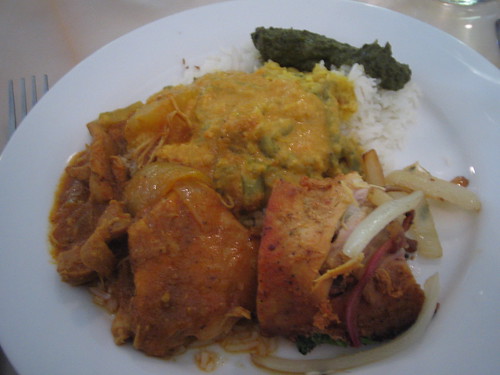
buffet lunch from my first visit
Also, they're open on Sunday!
September: farmville, only real.
At the end of September, I went to a consumer issues conference centering on food production and safety. It included tours of local facilities. First up was Grant Family Farms, a local organic farm. This is where we get our CSA. Check out these carrots.
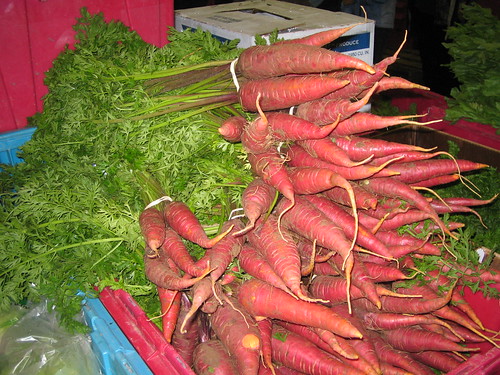
In addition to veggie shares, like the one I split with Rick, GFF does fruit, egg, meat, and flower shares. These flowers were in the cooler, all ready to be sent out for shareholders. I love all the gladioli!

We spent most of our time at the processing and packing facility, but we also go to see the livestock. They had pigs, chickens, ponies, sheep, and these cute goats. The goats resisted most of my efforts to photograph or otherwise interact with them. The sheep were not so shy. They'd been in a huge flock a ways away, but spotted me stalking them to take a photo and nearly charged me. Those suckers are aggressive and big talkers. Baaa!
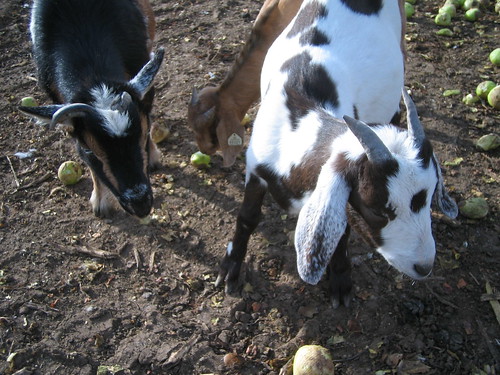
These eggs were being cleaned by hand and packed into cartons for sale.

The next day, we toured the university student farm and the university meat lab. The student farm is really small, but they manage to produce quite a bit of food. During summer, I try to buy their stuff at the farmer's market, but sometimes they sell out before I make it down. There wasn't much still growing, but it was interesting to see how they work, and the student volunteers were really great tourguides.
One thing they do year round is compost. These bins are full of finished compost that's ready for use. I need to remember to start collecting compostable scraps, because they let anybody drop stuff off there. I don't garden, so I haven't bothered, but I'd like to reduce my garbage even more than I am through recycling and buying less packaging.

Tools in the corner of the hoop house.
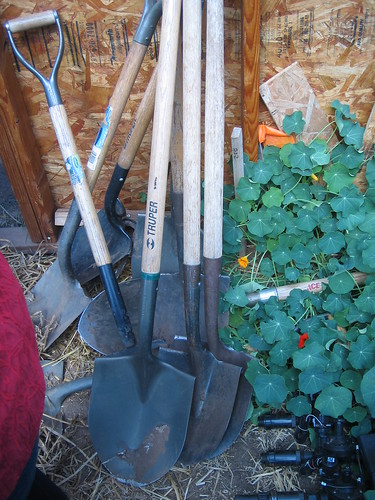
There were lots of things still growing in the hoophouse: tomatoes, tomatillos, swiss chard, edible nasturiums, salad, etc. I liked the perspective from the far end of the house; another group is touring at the other end.

My favorite tour was last. The meat lab was fascinating, and seeing it convinced me to sign up to buy meat from the college of agriculture. Their facility is amazingly clean and efficient. If you've read Fast Food Nation or the recent New York Times article about ground beef, you might have been turned off from eating meat, but not me. Living closer to the production of my food has made me appreciate and feel more comfortable with local, humane meat production, including hunting.
One of the Animal Science professors toured us through the facility, and we spent a lot of time on the slaughter floor learning about the process of killing and butchering cattle, sheep, and pigs. They use these animals as teaching tools, and I checked the course catalog to see what kinds of classes they offer. It's interesting to see titles like Carcass Fabrication, Livestock Slaughter, Meat Processing, and Livestock Judging. Here, our guide is showing us the cooler where meat is hanging and aging.
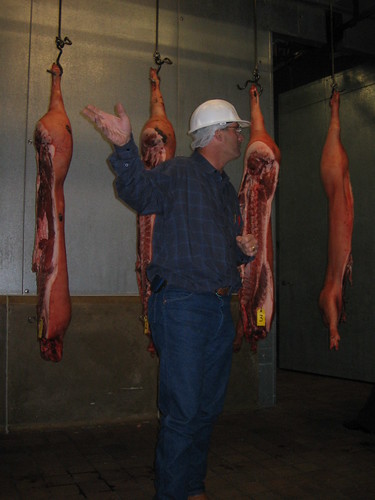
Students were processing meat while we were there. In another room, other students were preparing ribs to go into the smoker for the Ag Day barbeque the next day. They keep everything pristine in the meat lab. There are separate rooms for butchering and food preperation, and even separate walk-in fridges for raw and cooked meats.
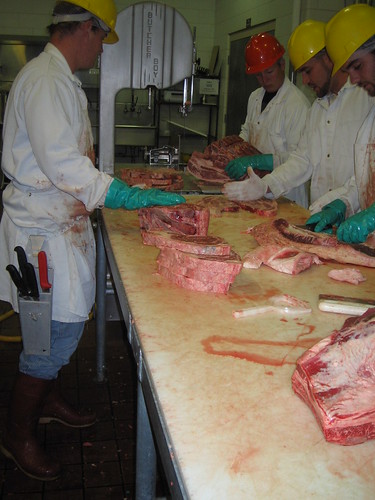
You know, I geek out on any kind of tour, especially food production. I can't count the number of times I've toured breweries or candy factories. But the farm and meat tours were more interesting to me, maybe because they're local and I feel personally connected to it. It makes me think back to high school, where we had a working farm I never even saw. I wasn't in any of the agriculture classes, and wasn't interested. But I bet the kids raising animals back then are a lot like the students I meet at the university now, and I'm kind of sad I totally overlooked it. Back then, I didn't have a clue you could compete in meat judging competitions or how much work that is.

In addition to veggie shares, like the one I split with Rick, GFF does fruit, egg, meat, and flower shares. These flowers were in the cooler, all ready to be sent out for shareholders. I love all the gladioli!

We spent most of our time at the processing and packing facility, but we also go to see the livestock. They had pigs, chickens, ponies, sheep, and these cute goats. The goats resisted most of my efforts to photograph or otherwise interact with them. The sheep were not so shy. They'd been in a huge flock a ways away, but spotted me stalking them to take a photo and nearly charged me. Those suckers are aggressive and big talkers. Baaa!

These eggs were being cleaned by hand and packed into cartons for sale.

The next day, we toured the university student farm and the university meat lab. The student farm is really small, but they manage to produce quite a bit of food. During summer, I try to buy their stuff at the farmer's market, but sometimes they sell out before I make it down. There wasn't much still growing, but it was interesting to see how they work, and the student volunteers were really great tourguides.
One thing they do year round is compost. These bins are full of finished compost that's ready for use. I need to remember to start collecting compostable scraps, because they let anybody drop stuff off there. I don't garden, so I haven't bothered, but I'd like to reduce my garbage even more than I am through recycling and buying less packaging.

Tools in the corner of the hoop house.

There were lots of things still growing in the hoophouse: tomatoes, tomatillos, swiss chard, edible nasturiums, salad, etc. I liked the perspective from the far end of the house; another group is touring at the other end.

My favorite tour was last. The meat lab was fascinating, and seeing it convinced me to sign up to buy meat from the college of agriculture. Their facility is amazingly clean and efficient. If you've read Fast Food Nation or the recent New York Times article about ground beef, you might have been turned off from eating meat, but not me. Living closer to the production of my food has made me appreciate and feel more comfortable with local, humane meat production, including hunting.
One of the Animal Science professors toured us through the facility, and we spent a lot of time on the slaughter floor learning about the process of killing and butchering cattle, sheep, and pigs. They use these animals as teaching tools, and I checked the course catalog to see what kinds of classes they offer. It's interesting to see titles like Carcass Fabrication, Livestock Slaughter, Meat Processing, and Livestock Judging. Here, our guide is showing us the cooler where meat is hanging and aging.

Students were processing meat while we were there. In another room, other students were preparing ribs to go into the smoker for the Ag Day barbeque the next day. They keep everything pristine in the meat lab. There are separate rooms for butchering and food preperation, and even separate walk-in fridges for raw and cooked meats.

You know, I geek out on any kind of tour, especially food production. I can't count the number of times I've toured breweries or candy factories. But the farm and meat tours were more interesting to me, maybe because they're local and I feel personally connected to it. It makes me think back to high school, where we had a working farm I never even saw. I wasn't in any of the agriculture classes, and wasn't interested. But I bet the kids raising animals back then are a lot like the students I meet at the university now, and I'm kind of sad I totally overlooked it. Back then, I didn't have a clue you could compete in meat judging competitions or how much work that is.
Subscribe to:
Posts (Atom)









